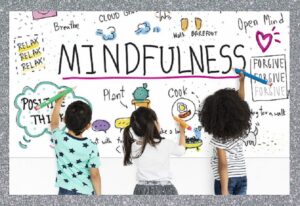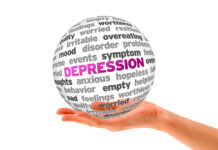EDITOR’S CORNER
Back in May, I wrote about the many ways that schools aren’t safe for kids’ physical and mental health. Since then, new threats are on the horizon: As the Today show reported last month, a district in Missouri has brought back corporal punishment (a.k.a. physical assault) as a form of student discipline—and parents are opting in. As you might expect, students are pushing back with protests, concerned about their lack of consent and the potential for abuse behind closed doors.
Research shows that corporal punishment isn’t effective in improving kids’ behavior and leaves lasting damage to their psyches. It also can’t be good for kids’ mental health when the adults who are supposed to educate them instead humiliate and hurt them. (And how must it feel to know your parents are OK with that?) Other research, as reported in an NPR story on the district’s move, shows that physical punishment is disproportionately meted out to Black and disabled students. Mainstream mental health organizations, including the American Psychological Association and the American Academy of Child & Adolescent Psychiatry, oppose it. Yet 19 states still allow the practice, following a 1977 Supreme Court ruling that it is constitutional. Is your state one of them?

Emotional Wellness Initiatives
Fortunately, the news is not all bad. I’ve been collecting articles about new school-based programs and services intended to safeguard students’ emotional well-being. Some of the trends include:
- Mindfulness Lessons. Schools have always offered real-world skill-based classes such as shop and public speaking, and now schools across America are teaching self-awareness. One of these programs, being implemented across Michigan, is called TRAILS. Among other things, it trains teachers to coach K-12 students to identify their feelings and develop CBT-based emotional regulation skills. Elsewhere in Michigan, teachers encourage students to learn and practice the “Four Circles of Self-Care” (physical, mental, emotional, and spiritual) and to keep a journal. Such mindfulness lessons are part of a larger, long-term trend called the Whole Child approach to education, which typically incorporates Social and Emotional Learning into the academic curriculum.
- Safe Spaces. Schools are providing retreats for youth who are having a bad day or a hard time generally. One Buffalo, NY school has a mindfulness room, complete with dim lighting and yoga mats, where stressed-out kids can talk to an adult about what’s bothering them. (The city’s public system has similar programs in its other schools, where children can practice relaxation techniques such as deep breathing, drawing, etc.)
- Time Off. If a short time-out isn’t enough, high schools in 10 states including Arizona and Maine are offering students “mental health days,” an excused absence for struggling youth who may need a break from school pressures to collect themselves.
- Liaisons. In Alabama, there is now a statewide program to place “mental health coordinators” in schools. Among other things, these paraprofessionals help connect troubled students and their families with customized local resources (if they want them) and organize programs on issues like bullying and suicidality.
The subtext of the articles covering these initiatives is that they are a stop-gap solution to the “real problem” of too few professional psychologists, psychiatrists, and social workers in schools and communities. (This perceived lack recently prompted new mental health funding from the Biden Administration as part of a comprehensive national strategy.) Though data validating these new, preventative approaches are still being collected, they sound worthy in their own right: They prioritize self-reflection and making thoughtful choices over identifying “mental illness symptoms,” are designed to be tailored to the communities they serve, and are available to any and all students (not just those with a diagnostic label).
Possible Pitfalls
For all their positive potential, though, I hope these programs won’t become a backdoor way to “screen” children for mental illness, then vector them into psychiatric treatments they might not need when other supports may be more appropriate. It’s somewhat concerning, for example, that West Hertel Academy’s mindfulness initiative has kids fill out a daily form about how they are feeling. Social and Emotional Learning has been shown to nurture both better academic achievement and happier kids, but I hope the mindfulness lessons don’t make kids so hyperaware of their emotions that they constantly self-monitor. Or cause adults to overreact when they hear youths expressing strong feelings, like whipping out a suicidality assessment form if kids use certain words. (The form is part of the TRAILS program, which includes a “risk management” component.)
And while school mental health coordinators can help kids and families access professional help or learn about issues they may not have known about, the coordinators may be tempted to target and coerce their school’s “problem” students. They’re also likely to direct people to the same conventional, biomedical approaches that have poor or unknown long-term results.
To say nothing of what these programs ask of teachers: That they tend to their students’ hearts as well as their minds. Educators are already leaving the profession in droves for other reasons, including curriculum censorship and being expected to act as human shields in active-shooter situations. Still, for those with the heart and grit to do it, sometimes a teacher is the only safe adult in a child’s life, and these programs implicitly acknowledge that.
Should parents support such programs? If one appeared in my children’s school, I would make a point of learning about it, and even ask them what they think of it. I wouldn’t, however, be automatically suspicious, like some parent groups that believe school mental-health initiatives usurp parents’ rights and inaccurately link SEL-based programs to Critical Race Theory (typically found at law schools, not in kindergartens).
Addressing Underlying Problems
I’m more heartened by other programs that, rather than asking teachers to become lay therapists or meditation instructors, actually help students address specific stressors in their lives. They’re not called mental health programs, but in effect, that’s what they are.
For example, a 2019 Washington, D.C. law, implemented last year, gives teenage victims of sexual assault the right to an advocate to support them and help them navigate their options. The district’s schools are intended to play an important role in the network of agencies involved (although this has happened to a limited extent thus far). This initiative is important, as 1 in 9 youth under 18, mostly girls, are sexual assault victims.
And now, thanks to recent legislation, each of California’s community colleges will offer centers to help students fulfill basic needs such as food and housing. Tailored to each campus, the hubs offer help with anything from accessing low-cost medical care or public benefits to paying for car insurance or internet service. These centers make it easy for teachers or other students to refer youth for assistance.
Both of these initiatives came from the policy arena, validating the idea that it’s at least as important to address young people’s distress at the community level as at the individual level. As I mentioned, the jury’s still out as to how effective school-based mental health initiatives are. Are you familiar with any in your area? What do you think of them?















Mindfulness in the schools, in everyone’s life, is good. I think it is necessary.
But when you introduce and idea like:
“identify their feelings and develop CBT-based emotional regulation skills”,
and say that Mental Health and Well Being might be compromised, you are making children subject to abuse and without redress, just as they would be if they were interned in a psychiatric hospital.
Joshua
Report comment
Young people need to be schooled in where to draw lines with adult authorities, and in how they should do this.
They need to learn to shut off authorities who are saying they need therapy, or anything like CBT, or in any other way are trying to turn problems with adults back on to the child, or trying to mess with their heads.
If a child told me that some adult authority in their school was telling them that they need CBT, I would tell them to walk straight to the police station and log it as a report of criminality.
Then I would say that they need to find a lawyer without wasting any time.
Joshua
Report comment
The school system is toxic for millions of young people and families are chronically stressed in myriad ways making home life painful too. These are all shaped and influenced by power, politics and economic decisions. CBT tells us the issues are within the individual in faulty thinking, beliefs and behaviours. McMindfulness is about accepting what is and getting on with it. If you read William M Epstein’s analysis of the psychotherapy research and others they tell us none of it has any evidence of efficacy and can be harmful.
We need to address our many and varied cultural disorders and stop making it about the individual, these are political and economic disorders. The mental health industry by and large helps to maintain the status quo by obfuscating the real causes of suffering in the world.
Report comment
“McMindfulness” – – now THAT’S a term that means something.
Having young kids fill out a questionnaire about feelings is wrong. It’s too focused and inappropriately intellectualizes emotions they’re probably not ready to understand and deal with in a safe way. And it also violates their privacy, as you can be damn sure someone somewhere will misuse the information. Screening makes kids targets.
Report comment
Then if I were the parent of a child being told they need CBT, besides going to a lawyer and the police myself, I would go to the School Board and demand in front of witnesses that that adult authority never be allowed to speak to my child again.
Joshua
Report comment
https://youtu.be/d1sI27JZPYc
Thank you Miranda for such a comprehensive and balanced article.
This video clip is of a Gibbon mom and infant. I found it yesterday by chance.
The mom looks ambivallent at moments. This or mystified. Then pleased. Then uncomfortable. Then irked. Then fascinated. Then contemptuous. Then doting.
The ambivallence is enthralling to see. A tree is ambivallent. This new infant is going to drown in an ocean of tree canopies if it does not stay shocked enough to cling. A tree is not going to save it. The baby is expected to literally “get a grip”.
If this video were of a human parent and their human newborn the human parent would be arrested for negligence.
But humans are animals. One’s who are not so far removed from gibbons. Resilience is an important skill that feeds a lot of needs that come under the awning of self-confidence and courage. This gibbon baby is being taught self-confidence not by a batch of “lessons” in a school but by going with the flow of literal and emotional “balance”. The gibbon baby may seem to thrive on neglect. A forest is a neglectful environment that just doesn’t give a damn about cute baby anything. A forest can be a heaven or a hell. This is why nature makes parents who play the part of ambivallent forest trees so that the infants grasp that life is not always going to be a bed of roses.
Ah but now human parents have been taught that to not show their kids undying devotion 24/7 is almost as toxic as murdering the little ones. Their offspring then grow up with no resilient coping strategies where it becomes quite clear that the world does not give a damn if they fall from grace or just fall from a bridge or tall building.
Psychotherapy is great when it is needed. I love psychotherapy. But it has entered the water supply and as such has become inappropriately served to those who do not want nor need it. Now anyone who imbibes psychotherapy can call themselves one. Until psychotherapy has become an ideology. Psychotherapy has become a zoo keeper, checking that all the stock are breeding properly. Telling gibbon moms how to nurse gibbon babies with more of a tender look in their eyes, make brimming eyes. The reality in good old nature is a bit of a refrigerator parent. In nature is a gibbon parent who wears their offspring like an irksome encumberance, as if the wriggling accoutrement were an off the shoulder satchel someone flung and said was all going down a riot in Paris.
We may well need “lessons” in how not to rear offspring but I rather think our propensity to keep giving “lessons” at all is the humany controlling and neurotic part that needs curbed.
The whole human species up until now has survived milennia of gibbonesque…terse moments of ambivallence.
Report comment
These are good points, and illustrate why I feel “iffy” about these programs (save for the ones that address unmet needs and aren’t really framed as mental health initiatives). I’m surprised more people aren’t upset about the corporal punishment, though!
Report comment
https://youtu.be/RGGP525IiCI
Where I live we used to have “the belt”. It was a long piece of thick unyeilding leather with two tongs on the end. Often it was only used as a threat of its use. But one day it was given to my poor palm….THWACKKK!!!!
Apparently I had flung an eraser. I would sooner fling a dull school book if I were to fling anything. I want the world to know “it was not me!”.
Was I deeply emotionally stunted? No. I was outraged. I was hurt. I was full of hatred. For weeks. But…I got over it. It was just the school being the midnight forest.
Years later there came news that “the belt” was to be banned. Most of the school room did not want it banned. Most of the school room knew that as soon as it was then the other kids who were remorseless bullies would rule the roost and noise up in study times and make learning anything impossible. The bullies became violent, not just to us sensitives but violent towards the teachers. The teachers had to shout above the racket which meant the women teachers with lighter voices had to shriek. Meanwhile I was routinely stabbed with school kit and my male friend was threatened with a bread knife for doing nothing. I became so despondent I did not go to school eventually and so my classes were in subjects like lonely carpark or lonely back yard or lonely scenic spot for a suicide. I am these days sure that NO child should be going to school AT ALL. Even the fee paying schools are DANGEROUS. More so than any pristine gibbon forest can be dangerous. All schools are awash with drugs and porn and mayhem that nobody needs when they are but a child. But that is only my understanding.
The video link I listened to podcast style as I painted a wall. At first I yawned at the plodding narrator but soon I became enthralled by his true account. As an amusement I put it here because it is about parenthood and how it can be done by an advanced civilization. I happen to believe that the extra terrestial visitors are simply “us”. They are us humans from the future, returning to pick a few berries and buy fashion wear and do sight seeing for the advanced children. Interestingly the parents ultimately PROTECT their children by not letting ANYONE come near them. As if they already know how our era is panning out and how far more psychologically balanced it needs to get to look after the most precious things we create.
But that “balance” is not found in academic sophistication. It is found in nature, where animals might not look like they care for their offspring but just some perverse onlooker try to walk off with any!
The parents in our far flung future let NO ONE interfere with childcare.
I wonder why that is……..
Report comment
Corporal punishment can be outlawed, but the people who defend it are not that far from the people who support mental health.
Joshua
Report comment
We have to get the entire mental health system and its concepts our of our lives.
Joshua
Report comment